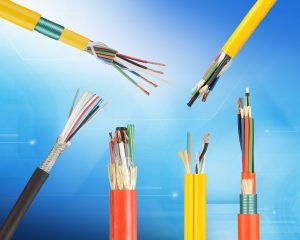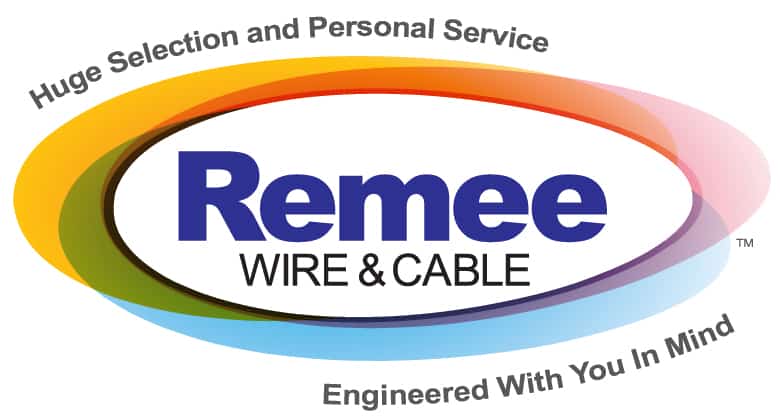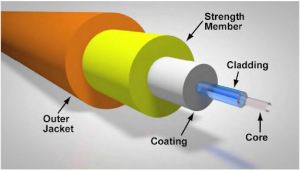Experience the art of custom fiber optic cable design with Remee Wire and Cable. Our team at Remee has mastered the craft over 50 years, offering organizations the perfect solution that aligns with their unique application needs. Continue on to discover how to design an American Made custom fiber optic cable with the top American cable manufacturer, Remee.
As a leading American Made wire and cable company, we take pride in delivering exceptional cable products, services, and innovation. Unleash the potential of fiber optics with our optimized design process, tailored to your requirements. Discover the Remee advantage and embark on a journey of unparalleled quality and reliability for your fiber optic cable needs.
Design an American Made Custom Fiber Optic Cables
The fiber optic cable market is expanding at an exceptional rate. Projections from Fortune Business Insights say that by 2027, the market will be up by 10.3% from 2020. This increase is 10 times that of standard cable.
The driving force behind this fiber optic cable market growth is an increased need for faster and more stable communications. The expectation is for the communications industry to continue to move to fiber optics in the future, with this cable type eventually becoming a cornerstone of the infrastructure.
Remee is ready to provide the highest-quality fiber optic cables that meet these growing demands. Through personalized service and a wide selection, we provide organizations with proven custom fiber optic cable products and give you control over every component, including:
- Type and configuration of fiber
- Number of fibers
- Jacket material
- Tight buffer or loose tube
- Gel-filled or dry tube
- Armor
To learn about the various kinds of fiber optic cables available from Remee, you can refer to our informative article that explains the different types of cables.
Type and Configuration of Fiber
Customize the configuration of your fiber optic cable to perfectly align with the requirements of your application. Thoughtfully consider the cable’s construction and take into account the presence of protective layers or coatings. The type and configuration of fiber significantly impact the cable’s overall performance, bandwidth capabilities, and its suitability for a wide range of applications.
Number of Fibers in Custom Fiber Optic Cable
Remee’s custom fiber optic cables offer the flexibility to tailor the number of fibers according to your specific requirements. This aspect varies based on the unique needs of each application, considering several factors that can influence the number of fiber cables necessary. Use our Fiber Design Guide to build your custom fiber optic cable.
Jacket Material
The jacketing on a fiber optic cable is the first line of protection for the internal components. Jacket materials are usually a plenum-rated polymer, such as Remguard, a riser-rated PVC, or OSP-rated polyethylene. Jackets also serve as a way to identify cables, so color-coding options are available.
Tight Buffer or Loose Tube
When deciding between tight buffer or loose tube configurations for a custom fiber optic cable, carefully evaluate your specific needs. Consider factors such as installation requirements, environmental conditions, and the level of protection required. The choice between a tight buffer or loose tube design significantly impacts cable flexibility, ease of termination, and resistance to external influences.
Gel Filled or Dry Tube
When selecting between gel-filled or dry tube configurations for fiber optic cables, it is crucial to assess your specific requirements. Consider factors such as moisture resistance, environmental conditions, and ease of installation. Our team of experts can help your organization determine the best solution based on your application.
Armor for Custom Fiber Optic Cable
Do you need an interlocked armor fiber optic cable? Find out by reading our article! When considering the addition of armor to fiber optic cables, it is essential to carefully evaluate your specific requirements. Take into account factors such as the intended application, installation environment, and potential hazards that the cable may encounter. The inclusion of armor provides enhanced protection against physical stress, such as impact, crushing, or rodent damage.
 Remee’s Custom Fiber Optic Cables and BABA
Remee’s Custom Fiber Optic Cables and BABA
Build America, Buy America also known as BABA is a recent act of Congress aiming to boost domestic manufacturing, create jobs, and enhance global competitiveness. It focuses on “infrastructure” projects, such as roads, bridges, public transportation, ports, railways, airports, water systems, electrical transmission facilities, utilities, and broadband infrastructures. This includes fiber optic cables and their components, as the government supports the use of USA-made products in fiber optic infrastructures.
Would you like to know more about BABA and Remee’s fiber optic cables? Our article provides detailed information about BABA, and you can also learn about Remee’s American-made fiber optic cables.
How To Design a Custom Fiber Optic Cable
Part of Remee’s exceptional customer service is our Fiber Optic Design Guide. This easy-to-use design tool will run through a series of questions that will allow us to see what your application requires. It is essential to provide as many details as possible to ensure your first consultation with us is as productive as possible.
To begin, the form asks for some basic information, including your name, email, phone number, and company contact details. Then, it moves into the aspects of your fiber optic cable needs.
Determine Fiber Optic Quantity
You can enter the quantity you need, either in feet or meters. Remee provides pre-cut spools of 1000 feet and cut-to-length options if you have a smaller cable project. You can get customized lengths for many of our fiber optic cable types.
Provide Competitor P/N
If you have a part number from a competitor, you can also provide us with that. Giving us this information enhances our ability to understand your needs and get an idea of what you’ve already considered. But if you don’t have one, just leave this blank.
Desired Fiber Type and Number of Fibers
Next is the bulk of the form where you provide detailed information about your desired cable. You will provide details on the fiber type and number of fibers you need.
The basic fiber type is either single mode (SM) or multimode (MM). The options include:
- Single Mode (SM) – 9/125μm OS2 .40/.30dB @ 1310/1550nm
- Multimode (MM) – 62.5/125µm OM1 1Gig 300mtrs @ 850nm
- Multimode (MM) – 50/125µm OM2 10Gig 150mtrs @ 850nm
- Multimode (MM) – 50/125µm OM3 10Gig 300mtrs @ 850nm
- Multimode (MM) – 50/125µm OM4 10Gig 550mtrs @ 850m
Giving us this starting point is important, as the mode helps to guide the overall design of your fiber optic cable. The mode affects how light moves through the cable. SM is thin and allows for one direction of travel, in contrast with MM, which is thicker and moves communications in multiple directions.
Despite SM being one-directional, it does allow less loss than MM and much higher bandwidths. However, MM is more cost-effective and works ideally at shorter lengths.
The number of fibers you need, or the fiber count, depends on the intended use. When choosing the fiber count, you should always think about the future. It is much easier to get more than you need now than to have to upgrade and re-pull cable at a later date. One rule of thumb is to get twice the number of fibers for your current usage.
Location of Fiber Optic Cable
The next section in the Fiber Optic Design Guide is the location where the cable is to be installed. You can install indoors, outdoors, or a combination of the two.
Outside installations may be buried or hung on poles. If you know which method you desire, then add a note to the form. Outdoor installations usually require far more cable than interior installation because they will typically cover miles of ground, and often require service loops. They also may require specific choices since some features may not work well in certain settings. SM is often the choice for outdoor applications when there is a need for fast transmission.
Indoor installations are for local use within a building. They usually use MM cable because they are running shorter distances. They also have far fewer durability concerns because of no exposure to weather or other natural elements.
Additional Comments on Custom Fiber Optic Cable Design
The last section of the guide is for you to add any comments. You can note specifics about your needs or overall cable design ideas. If you have any issues using our fiber optic design guide you can always ask an expert for more information.
Remee Wire & Cable Offers a Variety of Custom Fiber Optic Cable Features
Remee offers cable modifications or complete customization options for your cables. Our options include:
- Armored or unarmored
- SM, MM, OM3, or OM4 configurations
- Jacket types that include polyethylene, low-smoke zero-halogen, and PVC
- Fiber counts from 2 to 288
- Gel-filled options
- 10 GIG fiber types
- AquaLock® dry tube technology for loose tube fiber
- Activate™ PFCS (Hybrid Powered Fiber Copper Solutions)
Modified Standard & Custom Fiber Optic Cables
As a leading fiber optic manufacturer in the USA, Remee takes care to provide customers with the best options. Modified standard and custom fiber optic cables are a staple for us because we understand every customer’s needs are unique.
As a matter of fact, we have had to explore unconventional options to assist our clients in identifying the most suitable resolution for their needs. For example, we enabled the industry’s 1st fiber solution for intersection detection and actuation. You can learn more about Remee’s Solution: Activate™ in our blog.
Remee wants you to get a cable that will meet the demands of your environment and use. We can customize every part of your fiber optic cable design, from the jacket to the number of fibers.
Every detail is important as we design your cables. It is the small aspects of your cable design that Remee brings into focus for you.
If you need help with designing a custom fiber optic cable, our team of experts is available to assist you every step of the way. We want to ensure that you get the product that matches your cabling needs perfectly.
 Partner with Remee to Design Your American-Made Custom Fiber Optic Cable
Partner with Remee to Design Your American-Made Custom Fiber Optic Cable
Remee offers the opportunity to design the ideal fiber optic cable for your specific needs. With over 50 years of industry expertise, you can trust Remee to deliver a high-quality and dependable custom fiber optic cable for your organization.
What sets Remee apart is our commitment to manufacturing our cables in the USA, aligning perfectly with the new congressional Build America, Buy America Act. By choosing Remee, you not only receive top-notch products but also contribute to supporting domestic manufacturing.
As an industry leader in fiber optic cables, Remee is your go-to partner to ensure your organization receives the finest quality cables available. Join forces with us and unlock the full potential of your fiber optic infrastructure.

